Introduction
Lead magnets are the most important asset most people never build.
They’re not just freebies. They’re the first step in building trust, collecting leads, and turning interest into income.
A great lead magnet stops your best prospects from slipping away. It gives them a reason to engage, stick around, and take the next step, whether you’re selling a product, promoting an offer, or building an audience from the ground up.
This guide breaks down exactly what lead magnets are, why they still matter in 2025, how to create one that actually converts, and how to turn attention into long-term results.
No fluff. No theory. Just a proven system for lead magnets that work.
Disclaimer: I am an independent Affiliate. The opinions expressed here are my own and are not official statements. If you follow a link and make a purchase, I may earn a commission.
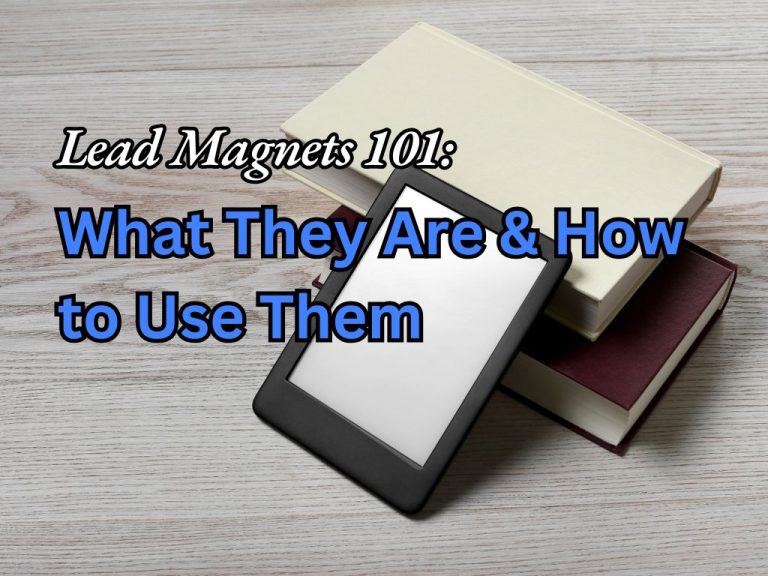
Key Takeaways | Lead magnets 101
- A lead magnet works when it solves one clear problem and delivers a quick win
- The best formats are checklists, templates, video trainings, quizzes, and short guides
- Every lead magnet should connect directly to the product or offer you plan to sell
- Headline, design, and landing page copy all influence how well it converts
- Promotion is just as important as creation. Your lead magnet should show up everywhere your audience already is
Why Lead Magnets Still Matter in 2025
Lead magnets still work because attention is short, trust takes time, and most people won’t take action on their first visit.
A lead magnet gives you a second chance. It captures attention, delivers value fast, and opens the door to a deeper relationship that can lead to sales.
Here’s why lead magnets remain essential in 2025:
1. They help you build an audience you control
You can’t rely on platforms. Algorithms shift, feeds disappear, accounts get throttled. A lead magnet lets you collect high-intent leads directly from your content, ads, or landing pages. You keep the access, the list, and the leverage.
2. They create trust before you ever sell
When you give something genuinely useful, like a checklist, PDF, or training, you prove your value upfront. This builds credibility and lowers resistance so people are more likely to engage when you do present an offer.
3. They boost conversions over time
Most people need more than one touch before they buy. A lead magnet keeps the conversation going, giving you space to educate, follow up, and sell when the timing is right.
4. They support any monetization model
Affiliate offers, coaching, product launches, memberships, blog traffic lead magnets work with all of them. They take cold interest and turn it into warm action, no matter what you’re selling.
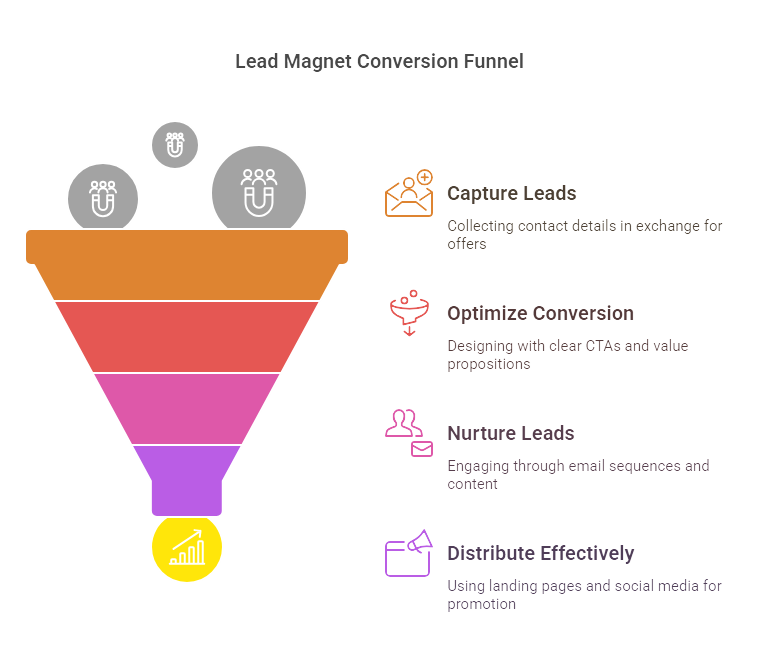
Types of Lead Magnets That Work in 2025
A great lead magnet doesn’t just collect emails. It attracts the right people, filters out the wrong ones, and prepares your audience for the next step.
It should be fast to consume, easy to deliver, and clearly aligned with the product or offer you eventually want to promote.
Here are six lead magnet formats that consistently convert across every niche:
1. Checklists and Cheat Sheets
These are quick wins that take your audience from scattered to clear in one page. They work especially well for beginners who are overwhelmed or don’t know where to start.
Example: “The 7-Step Blog Launch Checklist”
2. Templates and Swipe Files
Done-for-you assets that reduce friction and save time. They help your audience skip the blank page and take action immediately. These are powerful for people who are ready to execute but need a proven framework.
Example: “Copy and Paste Email Sequence for Affiliate Promotions”
3. Mini Guides and Playbooks
A step above a checklist, these offer strategic depth without overwhelming the reader. They help build authority and trust while giving your audience a roadmap toward a specific outcome.
Example: “The Beginner’s Blueprint to Monetizing a Niche Blog”
4. Video Trainings and Webinars
If your product or service requires demonstration, this is the way to go. A short video lets people see how you think, solve problems, and deliver value. Keep it focused and action-driven to avoid drop-off.
Example: “Launch Your Affiliate Funnel in 30 Minutes” complete screen share walkthrough
5. Free Trials and Demos
These work best for SaaS, tools, or memberships. The goal is to let your audience experience value firsthand before making a purchase. A great trial gives people a small but powerful result they’ll want to keep.
Example: “7-Day Free Trial of [Your Tool] with No Credit Card Required”
6. Quizzes and Assessments
Interactive and personalized, these are great for capturing attention and segmenting leads. They deliver value through insight while also guiding people to the best next step for them.
Example: “What Type of Creator Are You?” with custom recommendations
The format you choose depends on your audience and what they need most. What matters is that your lead magnet promises one clear outcome, delivers it fast, and creates a natural next step.
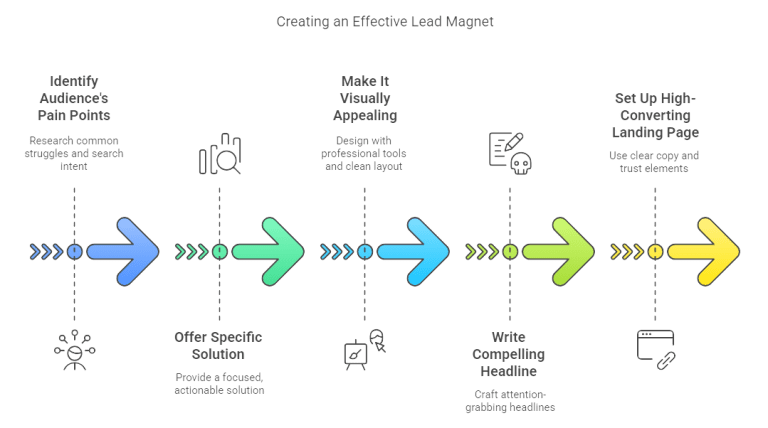
How to Create an Effective Lead Magnet
A lead magnet only works if it solves a specific problem your audience actually cares about.
If it’s vague, bloated, or irrelevant, people won’t download it and even if they do, they won’t stick around. The best lead magnets grab attention, deliver quick value, and create the perfect setup for what comes next.
Here’s how to build one that converts:
1. Identify a Specific Pain Point
Start with one clear problem your audience wants solved right now. Don’t try to be general or helpful to everyone. Use real questions from forums, search engines, and social comments to validate the pain point.
Example: Instead of “Affiliate Marketing Tips,” focus on “How to Pick the Right Affiliate Product as a Beginner.”
2. Create a Simple, Specific Solution
Your lead magnet should deliver one quick win. It doesn’t need to be long or complex, just useful. Focus on helping the user go from stuck to progress in one sitting.
Example: “10 Subject Line Formulas That Double Your Open Rates” is far more compelling than “Email Marketing 101.”
3. Make It Easy to Consume
Design matters more than most people think. If your PDF is messy or your video is bloated, you’ll lose attention. Keep the structure clear and visually inviting with short sections, bold headers, bullet points, and clean formatting. Use tools like Canva or Visme to polish the final product.
4. Write a Headline That Promises a Real Result
Your headline should focus on the outcome, not the format. Don’t lead with “Download my guide.” Lead with the benefit.
Better: “Get 5 High-Converting Email Templates You Can Copy Today”
Weaker: “Free Email Marketing PDF”
5. Set It Up on a Focused Landing Page
Don’t bury your lead magnet inside a cluttered blog post or random sidebar. Give it a dedicated landing page that sells the benefit clearly. Use a strong headline, a short list of what’s inside, and one call-to-action. Remove distractions. Add social proof if possible.
Once it’s built, your lead magnet becomes a permanent growth asset. You can promote it on your site, in your content, and across every channel where your audience shows up.
Once you’ve created your lead magnet and landing page, it’s time to put it to work.
To learn how to use already made lead magnets check out Top PLR Websites Guide.
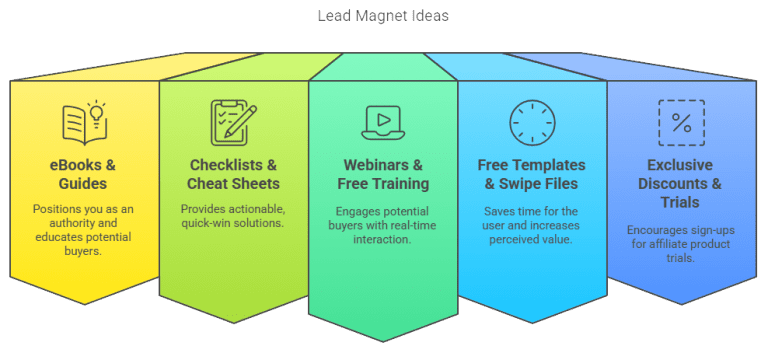
How to Promote Your Lead Magnet for Maximum Conversions
A great lead magnet won’t grow your list if no one sees it.
You can have the most valuable freebie in your niche, but if it’s buried or only shared once, it will never reach its potential.
Promotion matters as much as creation. Your lead magnet should be placed everywhere your audience already spends time. That doesn’t mean posting randomly, it means showing up with intent, where it counts.
Here are five proven strategies to promote your lead magnet and get more leads, faster:
1. Use a Dedicated Landing Page
Your lead magnet needs its own standalone landing page. Keep the copy short, benefit-focused, and free from distractions. This gives you one clean URL to use across blog posts, ads, social profiles, and email.
Tip: Use tools like ConvertKit, Leadpages, or a clean WordPress page builder to get this live fast.
2. Add Pop-Ups and Exit-Intent Forms
Smart pop-ups still work when timed well. Trigger them after scroll, on exit intent, or when someone’s been on the page for 30 seconds. Offer a clear benefit, not just “join my list.”
Example: “Want my 7-step blog launch checklist before you leave?”
3. Promote It Through Content
The best time to offer a lead magnet is when someone is already engaged with content on the same topic. Embed it in blog posts, YouTube descriptions, podcast show notes, and tutorial videos.
Example: Add a CTA mid-article like: “Grab the exact email template I used here for free.”
4. Share Strategically on Social Media
Don’t just post the link. Build interest first. Use Instagram Reels, Facebook posts, or LinkedIn carousels to tease the benefit. On Pinterest, turn your lead magnet into a vertical pin with a bold, results-driven title.
Focus on outcome, not format. Show the transformation.
5. Follow Up with an Email Sequence
The promotion doesn’t end after the download. Set up a simple welcome sequence to deliver the lead magnet, build rapport, and guide subscribers toward your next offer. This is where your lead magnet turns into revenue.
Promotion is not a one-time task. Your lead magnet should be an ongoing part of your content strategy shared consistently, not just once.
Common Lead Magnet Mistakes to Avoid
A lead magnet doesn’t work just because it looks nice or sounds valuable. Even well-designed offers can fail if you miss key fundamentals.
Here are five common mistakes that sabotage conversions:
1. Being Too Vague
If your lead magnet sounds generic or unclear, people won’t care. You have to speak to a specific problem with a clear promise.
Avoid: “Get my free guide to success.”
Use: “Get 5 client-closing email scripts you can send today.”
2. Trying to Do Too Much
Over Delivering sounds nice but backfires fast. A 50-page eBook feels overwhelming. One specific, useful outcome beats a bloated asset every time.
3. Forgetting the Next Step
A lead magnet is only the beginning. If there’s no welcome email, no follow-up, and no path forward, you’re wasting the attention you earned.
4. Misaligned Messaging
If your lead magnet attracts one type of audience but your product serves another, you’re building the wrong list. Your lead magnet should lead naturally into what you sell.
5. No Clear Call to Action
Don’t just deliver the asset and disappear. Tell them what to do next while their attention is still high whether that’s reading your next email, watching a video, or checking out a related offer.
Avoiding these mistakes isn’t just about optimization, it’s the difference between list growth that pays off and one that never converts.
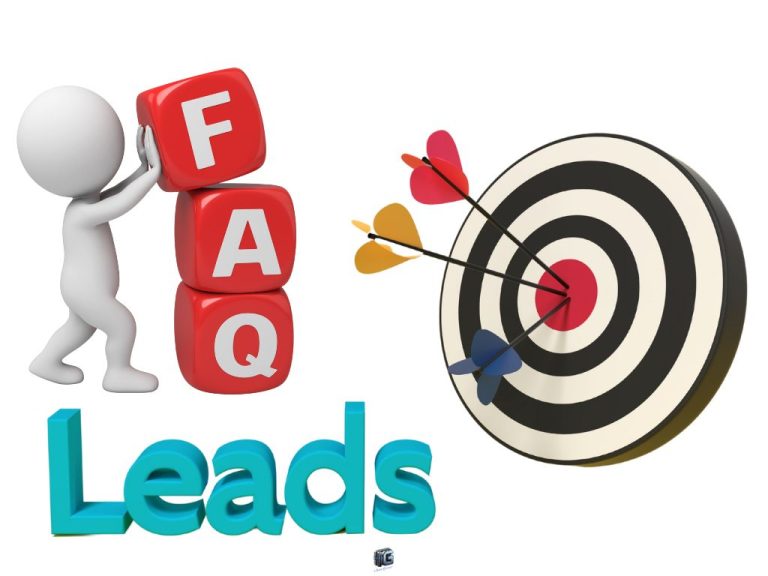
Frequently Asked Questions (FAQs)
1. What makes a lead magnet “high-converting”?
A high-converting lead magnet solves a specific problem for a specific audience. It delivers one quick win, is easy to consume, and leads naturally to your product, service, or next step.
2. How do I know which lead magnet works best for my audience?
Start with their pain point. What’s one thing they’re struggling with that you can help them solve fast? Look at comments, forums, search trends, and questions they’re already asking.
3. Do I need a website to use lead magnets?
No. You can promote lead magnets through landing pages, social media bios, link tools like Linktree, or paid ads. A website helps with long-term strategy but isn’t required to get started.
4. What tools do I need to create and deliver a lead magnet?
For design, use tools like Canva, Adobe Express, or Visme. For landing pages and delivery, try ConvertKit, MailerLite, ClickFunnels, or Leadpages. Start with what fits your skill level and budget.
5. How do I make money from my lead magnet?
Use follow-up emails to build trust, share useful content, and promote products or services. You can recommend affiliate tools, sell digital products, offer coaching, or introduce a paid offer at the right time.
6. How long should a lead magnet be?
It should be as short as possible while still delivering a result. Many of the best lead magnets are 1 to 3 pages, checklists, templates, or quick-start guides. Aim for clarity, not volume.
7. How often should I promote my lead magnet?
Consistently. Mention it in blog posts, emails, videos, and social media. Include it in your content strategy so it’s always working in the background to bring in new leads.

Want a Faster Way to Create High-Converting Lead Magnets?
Skip the design tools and tech headaches — use a system that builds, delivers, and tracks your lead magnets in minutes.
- Pre-built templates
- Email validation
- Seamless integrations
- One-click delivery
Conclusion: Lead Magnets Turn Traffic Into Trust
Lead magnets are more than just list-building tools. They are the first impression, the first promise, and often the first turning point in your relationship with a future customer.
When done right, they create momentum. They shift someone from passive visitor to active subscriber. From cold leads to warm opportunities.
Whether you’re selling digital products, promoting affiliate links, or building a personal brand, the right lead magnet helps you move people forward without pitching too early or pushing too hard.
Start simple. Focus on one real problem. Offer one clear win. Then put it everywhere your audience is already paying attention.
You don’t need a massive list. You need the right people saying yes.
📌 Ready to see what high-converting lead magnets actually look like?
Check out our Lead Magnet Examples That Drive Results and get inspired with proven formats you can use today.

2 Comments
Lead Magnets Examples: Best Lead Magnets for Different Niches - Ismel Guerrero. · February 19, 2025 at 7:09 pm
[…] For a deeper dive into the fundamentals of lead magnets, read our Lead Magnets guide. […]
Best Lead Generation Tools for 2025 (Free & Paid) - Ismel Guerrero. · April 15, 2025 at 11:48 pm
[…] out our Guide to Lead Generation and build a pipeline that runs on […]